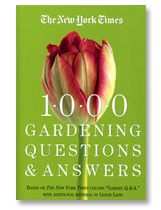Growing Garlic ( and Roasting It)
(Please scroll down or hit coming attractions for the Garden Tour Plant List)
With garlic, it’s almost impossible to fail completely. Plant one clove, get one multi-clove bulb, pretty much no matter what. The catch is that it’s quite easy to fail partially. I did for years, simply because I kept planting softneck garlic, the most common kind, even though I was in Maine and the garlic wanted to be in Southern California. Over and over, I got small bulbs filled with small cloves that were very tedious to peel, a defect slightly mitigated by the fact that the garlic was so incredibly strong and hot you didn’t need (or want) much.
What I’ve learned since:
* If you live in the North, plant hardneck garlic, the kind with the stiff stem running up the middle. It’s much hardier than softneck garlic. Bigger and sweeter, too. ( it doesn’t store as well, but it stores well enough).
* Big cloves make big bulbs. When you get your seed garlic, either at the farmers’ market or from a source like Filaree Farm; plant only the large outer cloves. Eat the smaller cloves at the center or plant them in the perennial border and let them stay there indefinitely, making larger and larger clumps of their gorgeous, twirly stems.
* Plant in well-drained, fertile, weed-free soil, in late September or early October. Goal is to have good strong roots but only short green shoots when hard frost puts growth on hold until spring.
* Garlic comes up early. So do weeds. Mulch helps, but you’ll probably still have to pull a few. The plants are too narrow to shade anything out and they have small, shallow roots that do not compete well.
* The combo of increasing warmth and lengthening days tells the plants to stop making leaves and start making bulbs. Energy to do this comes from those leaves, so the goal is to have them get as big as possible as soon as possible. ( A little fish emulsion at intervals never hurt anybody).
* Bulbs keep putting on size until mature and must be mature to store well, but if they stay in the ground after they’re ready, they split and spoil quickly. Generally speaking, it’s time to harvest when about half of the leaves have fallen over or turned brown or both. Dig on a dry day, brush off dirt, then spread the plants on racks ( screens on bricks, for instance) to dry. Ideal spot is a barn or shed that’s warm, dry and dark. Let the bulbs cure for about a month, then cut off the tops; hardneck is not braid material.
* Eat lots. No matter how you store it, it will start sprouting by February. We like:
Garlic Roasted With Olive oil and Potatoes: several head’s worth of peeled cloves for about 2 pounds of small , new potatoes. Big splash of oil in a jellyroll pan. Be sure potatoes are thoroughly dry, so they don’t stick. Roll everything around to coat well, then bake in the upper third of a 400 degree oven until interiors are soft and outsides have lots of crisp brown spots, about 45 minutes. Stir with a flat spatula from time to time. Malden salt at the half hour mark or at the end but not at the start.



